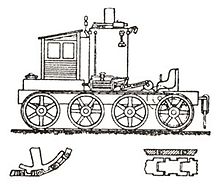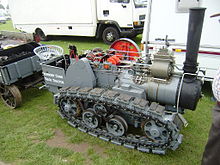- Tracked vehicle
-
A tracked vehicle (also called: track-type tractor, tractor crawler, or track-laying vehicle) is a vehicle that runs on continuous tracks instead of wheels. Tracked vehicles include construction vehicles, military armored vehicles and unmanned ground vehicles.
The principal design advantages of tracked over wheeled vehicles are that they are in contact with a larger surface area than would generally be the case with a wheeled vehicle, and as a result exert a much lower force per unit area on the ground being traversed than a conventional wheeled vehicle of the same weight. This makes them suitable for use on soft, low friction and uneven ground such as mud, ice and snow. The principal disadvantage is that tracks are a more complex mechanism than a wheel, and relatively prone to failure modes such as snapped or derailed tracks.
Contents
History
A long line of patents disputes who the "originator" was of this concept.
There were a large number of designs that attempted to achieve a track laying mechanism, although these designs do not generally resemble modern tracked vehicles.[1][2][3]
Blinov
In 1877 Russian Fyodor Abramovich Blinov created tracked vehicle called "wagon moved on endless rails" (caterpillars).[4] It lacked self-propelling and was horse-drawn. Blinov got a patent for his "wagon" the next year. Later, in 1881-1888 he created steam-powered caterpillar-tractor. This self-propelled crawler was successfully tested and showed at farmer's exhibition in 1896.[4]
Dinsmoor
According to Scientific American it was Charles Dinsmoor of Warren, Pennsylvania that invented a "vehicle" that was of endless tracks. The article gives a detailed description of the endless tracks and the illustration looks much like today's tracked vehicles.[5] The invention has been patented as No. 351,749 on November 2, 1886.[6][7]
Lombard
Alvin O. Lombard of Waterville, Maine was issued a patent in 1901 for the Lombard Steam Log Hauler that resembles a regular railroad steam locomotive with sled steerage on front and crawlers in rear for hauling logs in the Northeastern United States and Canada.[citation needed] The haulers allowed pulp to be taken to rivers in the winter. Prior to then, horses could be used only until snow depths made hauling impossible. Lombard began commercial production which lasted until around 1917 when focus switched entirely to gasoline powered machines. A gasoline powered hauler is on display at the Maine State Museum in Augusta, Maine.
Hornsby/Holt/Phoenix
After Lombard began operations, Hornsby in England manufactured at least two full length "track steer" machines, and their patent was later purchased by Holt in 1913, allowing Holt to claim to be the "inventor" of the crawler tractor.[8] Since the "tank" was a British concept it is more likely the Hornsby, which had been built and unsuccessfully pitched to their military, was the inspiration.
In a patent dispute involving rival crawler builder Best, testimony was brought in from people including Lombard, that Holt had inspected a Lombard log hauler shipped out to a western state by people who would later build the Phoenix log hauler in Eau Claire, Wisconsin, under license from Lombard.[citation needed] The Phoenix Centipeed typically had a fancier wood cab, steering wheel tipped forward at a 45 degree angle and vertical instead of horizontal cylinders.
Linn
In the meantime a gasoline powered motor home was built by Lombard for Holman Harry (Flannery) Linn of Old Town, Maine to pull the equipment wagon of his dog & pony show, resembling a trolley car only with wheels in front and Lombard crawlers in rear. Linn had experimented with gasoline and steam powered vehicles and six wheel drive before this, and at some point entered Lombard's employment as a demonstrator, mechanic and sales agent. This resulted in a question of proprietorship of patent rights after a single rear tracked gasoline powered road engine of tricycle arrangement was built to replace the larger motor home in 1909 on account of problems with the old picturesque wooden bridges. This dispute resulted in Linn departing Maine and relocating to Morris, New York, to build an improved, contour following flexible lag tread or crawler with independent suspension of halftrack type, gasoline and later diesel powered. Although several were delivered for military use between 1917 and 1946, Linn never received any large military orders. Most of the production between 1917 and 1952, approximately 2500 units, was sold directly to highway departments and contractors. Steel tracks and payload capacity allowed these machines to work in terrain that would typically cause the poorer quality rubber tires that existed before the mid 1930's to spin uselessly, or shred completely.[citation needed]
Linn was a pioneer in snow removal before the practice was embraced in rural areas, with a nine foot steel v-plow and sixteen foot adjustable leveling wings on either side. Once the highway system became paved, snowplowing could be done by four wheel drive trucks equipped by improving tire designs, and the Linn became an off highway vehicle, for logging, mining, dam construction, arctic exploration, etc.[citation needed]
Sloan
Once steel cleats became unpopular on paved roads, in 1938 a limited experiment began to bridge the gap between truck and tractor, a "convertible vehicle" patented by Phillip Sloan, the C5 Catruk, suffered design flaws and limited production before it was finally abandoned.[citation needed]
Fate of pioneer companies
Lombard gasoline production was more limited as they never managed to diversify use away from log hauling; it is believed a diesel built in 1934 was their last unit.
Phoenix, of Eau Claire, Wisconsin, appears to have built at least one gasoline powered machine before fading into history.[citation needed]
Holt and Best ended up merging. Holt had registered the trademark "Caterpillar". The merged company produced a version of the Best 60 tractor, which later became the Caterpillar 60. The new corporation took the name Caterpillar Inc. in approximately 1925, and remains in business today.
Current manufacturers
For certain tasks, such as soil preparation and maintenance on very steep slopes, crawler tractors are still used. A notable example is vineyards, e.g. in Italy.[9] Today, the pioneer manufacturers have been replaced mostly by large tractor companies such as John Deere, New Holland, Kubota,[10] Case, Caterpillar Inc., CLAAS.[11] Also, there are some crawler tractor companies specialising in niche markets. Examples are Otter Mfg. Co. and Struck Corporation.[12]
Examples
- The crawler tractor was the basis of the first designs of tank.
- Crawlers equipped with a blade are called bulldozers, and used for construction and earthmoving projects.
- tracked machines equipped with a shovel or bucket are often called a "Traxcavator", but are a Tracked Shovel or Loader. The "Traxcavator" name was a brand of the Trackson company and was bought by Caterpillar Inc. in the 1950.
- Crawler design have been intermittently popular for farm use.
- Track Marshall being a brand built in Britain till the 1980s.
- The space shuttle is transported to its launch site by a large crawler-transporter.
- One of the largest crawlers in the world is the German bagger 288 excavator.
Other types of tracks
See also
- Screw-propelled vehicle
- Snowmobiles
- Tanks
- Snow Tracs
- Kristi Snowcat
- Sno-Cat
- Snow coach
- Bv 202
- Bv 206
- Half-track
References
- ^ US patent 69987, James K Glen, "Improvement in Motive Power", issued 1867-10-22
- ^ US patent 373887, William Fender, "Wheel With Endless Rail", issued 1887-11-29
- ^ US patent 433488, Goldsbury Harden Pond, "Traction Engine", issued 1890-08-05
- ^ a b The inventor of tractor (Russian)
- ^ Scientific American, December 18, 1886, Vol. LV, No. 25
- ^ Kane, Joseph Nathan, Famous First Facts, H. W. Wilson Company (1950), p. 47
- ^ US patent 351749, Charles Dinsmoor, "Vehicle", issued 1886-11-02 A design for a tracked vehicle.
- ^ "Caterpillar Tractor Co. List of Deals". Lehman Brothers Collection. President and Fellows of Harvard College. 2010. Archived from the original on 2010-11-06. http://www.webcitation.org/5u2jB9nzf. Retrieved 2010-11-06. "In 1925 Holt and C.W. Best's company merged to form the Caterpillar Tractor Company."
- ^ Crawler tractors for vineyards
- ^ Kubota crawler tractor
- ^ CASE, Caterpillar, CLAAS crawler tractors
- ^ Otter & Struck manufacturing niche crawler tractors
External links
- Blinov's crawler[dead link]
- F. A. Blinov - in Russian
Categories:- Tracked vehicles
- Engineering vehicles
- Tractors
- Russian inventions
Wikimedia Foundation. 2010.



